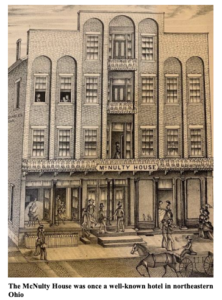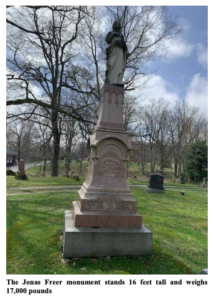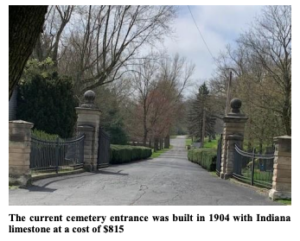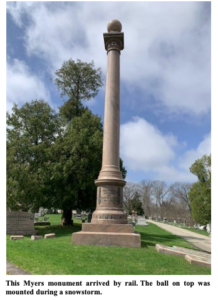105 West Main Street
We all know it now as the Uniontown Brewing Company, but Ashland citizens once knew the building at 105 West Main Street as the home of a few other very successful businesses over the years.

Thought to be originally built in 1850, the building was first owned by Dr. Joseph Sampsel and was a hotel known as the Sampsel House. The brick building was 50 feet by 70 feet and 3½ stories high. A fine balcony ran the whole length of the front across the second floor with smaller balconies in the center of the third and fourth floors. It also included an observatory that boasted an extensive view of Ashland and the nearby countryside.
The building was purchased in 1859 by William McNulty, a native of Franklin County, PA, from J. B. R. Sampsel and C. E. Sampsel. The purchase price was $13,325.22. McNulty turned the hotel into a first-class facility that had every comfort and convenience with a tavern and large stables in the rear. It was described as spacious and well-furnished inside. The hotel became a downtown hub of activity on Main Street and was well-known as one of the best hotels in this part of Ohio.
The stagecoach with its four horses visited Ashland a few times a week from the east and west. Once daily trips were established between Ashland and Mansfield, the stagecoach left the McNulty House at 6:30 each morning and returned from Mansfield in the evening. This was another reason it became a desirable place to stay. Politicians, lecturers, and entertainers often spent the night at the McNulty House until they moved on to their next meeting or performance.
There was a ballroom on the fourth floor of the hotel. Many events were held during the holiday season. Soldiers often danced there with their girls when home on furlough. The Ashland Cornet Band also played on the long, second-floor balcony on Saturday evenings.
On February 27, 1873, the McNulty House caught fire. Residents formed bucket brigades passing water from nearby cisterns and wells as the fire department got their hoses ready. The building suffered some damage but was saved from total destruction.
William McNulty died in 1890 shortly after he retired from his hotel business. George Hemingway purchased the building and renamed it the Hemingway. At the turn of the century, The Hemingway was well-known as a rooming house for unattached men. A travelers’ library was established, and a five-and-dime store was housed in a downstairs room.
In 1914, the building was purchased by George M. Gilbert, who moved his furniture and undertaking store from 14 Orange Street to the Main Street location. The famous balcony was determined to be unsafe and was removed as part of the remodeling project. Mr. Gilbert came to Ashland in 1886 from Lodi, Ohio, and established his furniture business into one of the largest household furnishing establishments in Ohio. In 1972, Gilbert’s celebrated its 100th anniversary and was still family-owned.
Many old furniture stores had a mortuary attached because they also made caskets. When Gilbert moved his business to Main Street, it included a funeral home with a seating capacity of 120 people. In 1939, the funeral home was relocated on Claremont Avenue in the former Maurice Semple home. It is now Wappner Funeral Home.
Amie Van Hove purchased Gilbert’s Furniture Company from the Gilbert family in 2005, but it closed in 2008 with the distinction of being Ashland’s oldest retail establishment.
In July 2016, Doug and Anna Reynolds purchased the building and renovated it, later opening it as what we know now as a successful microbrewery and restaurant, and a more modern-day hub of activity for downtown Ashland.

 Many locals routinely walk at the Ashland Cemetery, and it’s certainly an interesting place to take a stroll and educate yourself about local history. It’s also a great topic for students to write a report about and a wonderful location to play “I Spy,” so I won’t give up all the information we have about it at the Ashland County Historical Society!
Many locals routinely walk at the Ashland Cemetery, and it’s certainly an interesting place to take a stroll and educate yourself about local history. It’s also a great topic for students to write a report about and a wonderful location to play “I Spy,” so I won’t give up all the information we have about it at the Ashland County Historical Society!
 By 1909, the association had purchased 30 additional acres, and over the years, about 35 more acres have been added. According to former cemetery superintendent, George Hickman, in 1987, there were enough burial plots to last another 200 years. This statement still holds true today, according to Association President Jim Doyle who also stated, “Plans are now being created for future expansion of additional plots on cemetery association-owned land.”
By 1909, the association had purchased 30 additional acres, and over the years, about 35 more acres have been added. According to former cemetery superintendent, George Hickman, in 1987, there were enough burial plots to last another 200 years. This statement still holds true today, according to Association President Jim Doyle who also stated, “Plans are now being created for future expansion of additional plots on cemetery association-owned land.”